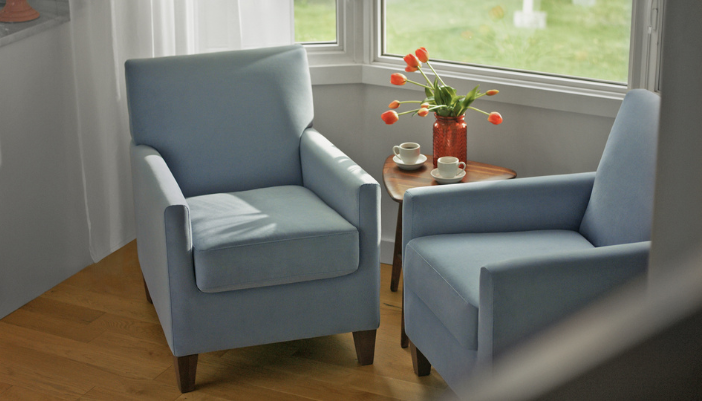
Living in a smaller home or apartment doesn't mean sacrificing style or comfort. With thoughtful planning and strategic furniture arrangement, even the most compact spaces can feel open, functional, and welcoming. At Smitty's Furniture, we understand the unique challenges of furnishing smaller spaces, and we've helped countless homeowners transform their compact rooms into comfortable, efficient living areas.
Here are five expert tips for arranging furniture in small spaces to maximize both functionality and style.
1. Measure Twice, Purchase Once

The most critical step in furnishing a small space happens before you even begin shopping or rearranging: precise measurement.
Why Measuring Matters
In compact spaces, even a few centimetres can make the difference between a comfortable fit and a cramped room. Furniture that's too large will overwhelm your space, while pieces that are too small might fail to provide the functionality you need.
What to Measure:
- Room dimensions: Total width and length of your space
- Traffic pathways: Allow at least 75-90 cm for comfortable movement
- Doorways and entrances: Consider how furniture will get into your home
- Window and radiator locations: Avoid blocking natural light or heat sources
- Wall space: Note areas available for taller pieces
- Ceiling height: Important for tall furniture or hanging lights
Pro Tip:
Create a simple floor plan on graph paper or use a room planning app. This allows you to experiment with different layouts before moving heavy furniture. Include all architectural features like windows, doors, and built-in elements.
At Smitty's, we offer a complimentary check measure service where our professionals can visit your home to take precise measurements and help you plan your furniture arrangement. This service has saved many customers from purchasing beautiful pieces that wouldn't fit through their doorways or function properly in their spaces.
2. Choose Multi-Functional Furniture

When space is limited, every piece of furniture should earn its place by serving multiple purposes.
Look for Pieces That:
- Offer storage: Ottoman storage, beds with hidden storage, coffee tables with shelves
- Transform as needed: Extendable dining tables, sleeper sofas, nesting tables
- Serve dual functions: A desk that doubles as a dining table, an ottoman that works as seating and a coffee table
Tip: Smitty’s Furniture has plenty of options for all of these pieces. Reach out to us and we would be happy to assist you in finding the piece that your home needs.
Smart Multi-Functional Options:
- Sectionals with storage: Sectional sofas with built-in storage compartments like the Decor-Rest 2786 sectional help you maximize seating while providing hidden space for blankets, books, or seasonal items.
- Murphy beds: These wall-mounted beds fold up when not in use, instantly converting your bedroom into a living space during waking hours.
- Extending dining tables: Tables that expand for guests but remain compact for daily use are perfect for small dining areas. Consider the Amisco Zenith Table as an example.
- Nesting tables: Tables like the Hekman Nesting Tables can be spread out when entertaining or stacked and tucked away to save floor space when not needed.
Canadian manufacturers like Brentwood, Palliser, and Decor-Rest offer customizable furniture that can be tailored to fit smaller spaces without sacrificing comfort or quality. Many of these pieces are available in apartment-friendly scales with options for customization that make them perfect for small-space living.
3. Embrace Proper Scaling
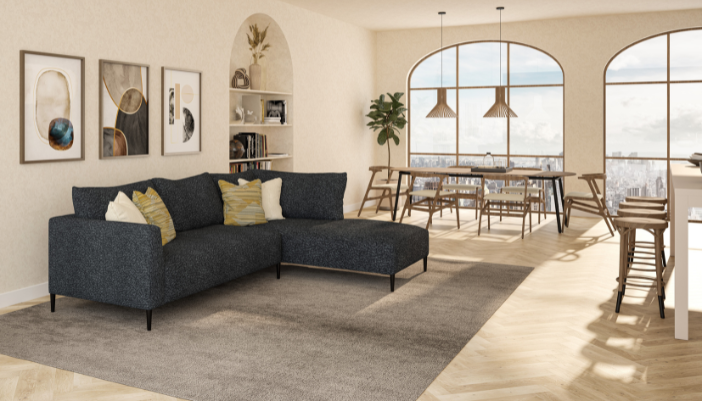
In small spaces, scale and proportion become even more important than in larger rooms. The right-sized furniture creates balance and prevents your space from feeling cluttered or cramped.
Scaling Guidelines:
- Choose furniture with a lighter visual weight: Pieces with exposed legs allow you to see the floor beneath, creating a sense of openness
- Select lower-profile seating: Chairs and sofas with lower backs won't overwhelm a small room
- Pay attention to depth: Look for sofas and chairs with narrower depths (75-85 cm rather than 100+ cm)
- Consider armless options: Armless chairs take up less visual and physical space
- Opt for smaller side tables: Replace bulky end tables with more delicate alternatives
Avoid Common Scaling Mistakes:
Too many small pieces: While it might seem logical to fill a small room with small furniture, too many tiny pieces can actually make a space feel cluttered and disorganized. Instead, choose a few moderately-sized, multi-functional pieces.
Pushed-back furniture: Contrary to popular belief, pushing all furniture against the walls doesn't necessarily maximize space. Sometimes floating furniture away from walls creates better traffic flow and more usable space.
Ignoring vertical space: In small rooms, thinking vertically is essential. Wall-mounted shelving, taller (but narrower) storage units, and hanging lights can free up valuable floor space.
The beauty of custom Canadian-made furniture from manufacturers like those carried at Smitty's is that pieces can often be ordered in apartment scales or with customized dimensions to perfectly fit your space.
4. Create Zones with Thoughtful Arrangement
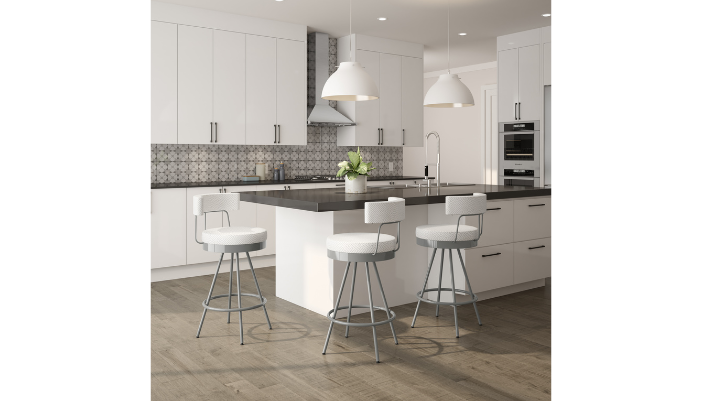
Even the smallest spaces typically serve multiple functions. Creating distinct zones helps organize your space logically and makes it feel more spacious and purposeful.
Zoning Strategies:
- Use area rugs: Define separate areas with different rugs
- Arrange furniture in conversational groups: Position seating to face each other
- Create visual dividers: Use bookcases, screens, or even plants as room dividers
- Consider traffic patterns: Ensure clear pathways between zones
- Maintain sight lines: Allow visual flow between areas to maintain a sense of openness
Zone Ideas for Common Small Spaces:
Studio apartments: Create separate sleeping, living, and dining zones through furniture arrangement and visual cues like rugs or lighting.
Open-concept spaces: Define the living area with a rug and conversation-oriented seating, then position dining furniture on a different wall to create separation.
Multi-purpose rooms: For rooms that serve as both offices and guest rooms, choose furniture that can adapt to both functions and arrange pieces to highlight the primary function most of the time.
Modular furniture, like sectionals that can be reconfigured or expanded over time, offers flexibility as your needs change. Many Canadian manufacturers offer modular options that can be tailored to your unique space.
5. Maximize Vertical Space and Use Visual Tricks
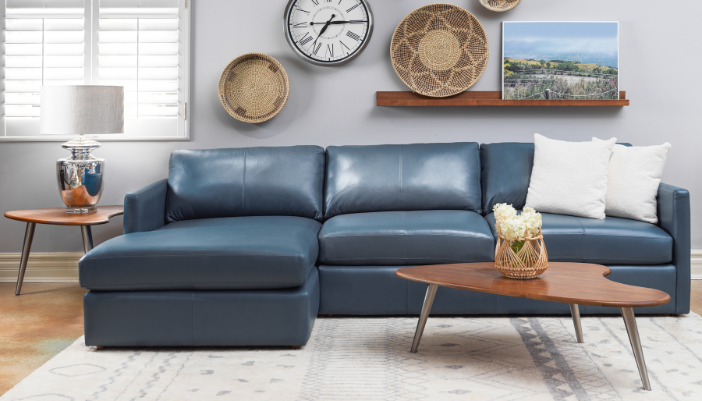
When floor space is limited, looking upward opens new possibilities. Additionally, incorporating visual tricks can make your space feel larger than it actually is.
Vertical Solutions:
- Wall-mounted shelving: Frees up floor space while providing storage and display areas
- Taller, narrower bookcases: Offers storage with a smaller footprint
- Hanging pendant lights: Eliminates the need for floor or table lamps
- Over-door organizers: Utilizes often-forgotten space
- Floor-to-ceiling curtains: Creates the illusion of higher ceilings
Visual Expansion Tricks:
- Mirrors: Strategically placed mirrors reflect light and create the illusion of more space
- Glass or acrylic furniture: Transparent pieces take up less visual space
- Consistent colour palette: Using similar tones throughout creates flow and openness
- Leg furniture: Pieces with visible legs create a sense of airiness
- Proper lighting: Well-lit spaces feel larger and more open
Small-Space Lighting Tips:
Effective lighting is particularly important in small spaces. Consider these strategies:
- Layer your lighting: Combine ambient, task, and accent lighting
- Use wall sconces: Saves valuable table and floor space
- Consider cove lighting: Creates the illusion of higher ceilings
- Add dimmers: Provides flexibility for different activities and moods
- Incorporate reflective surfaces: Amplifies available light
At Smitty's Furniture, we offer lighting solutions that complement our furniture and maximize space efficiency, helping you create a well-lit environment without sacrificing precious floor space.
Bringing It All Together
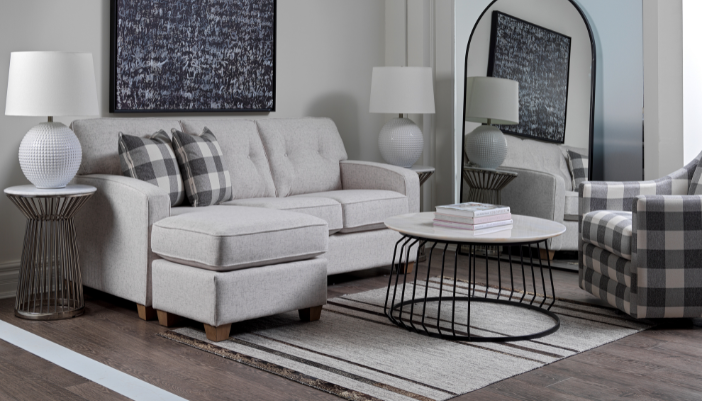
Arranging furniture in small spaces requires thoughtful planning and strategic decision-making, but the results can be both beautiful and functional. Remember these key principles:
- Measure carefully before purchasing or rearranging
- Choose multi-functional pieces that work hard for their footprint
- Pay attention to scale for visual and physical comfort
- Create zones to organize your space logically
- Use vertical space and visual tricks to maximize and expand your space
Whether you're furnishing a cozy apartment, a compact condo, or a small room in a larger home, these strategies will help you create a space that feels open, organized, and inviting.
At Smitty's Furniture, we understand the unique challenges of furnishing smaller spaces. Our design consultants are experts at helping you select appropriately scaled, multi-functional Canadian-made furniture that will make the most of your compact living areas. We offer complimentary design consultations at our Kitchener and Hanover locations to help you find the perfect furniture solutions for your small space.
Remember that our Hanover location is also home to the GE Appliance Centre, offering space-efficient appliance solutions to complete your small space design.
With the right approach and the right furniture, even the smallest spaces can become comfortable, stylish sanctuaries that perfectly suit your lifestyle.